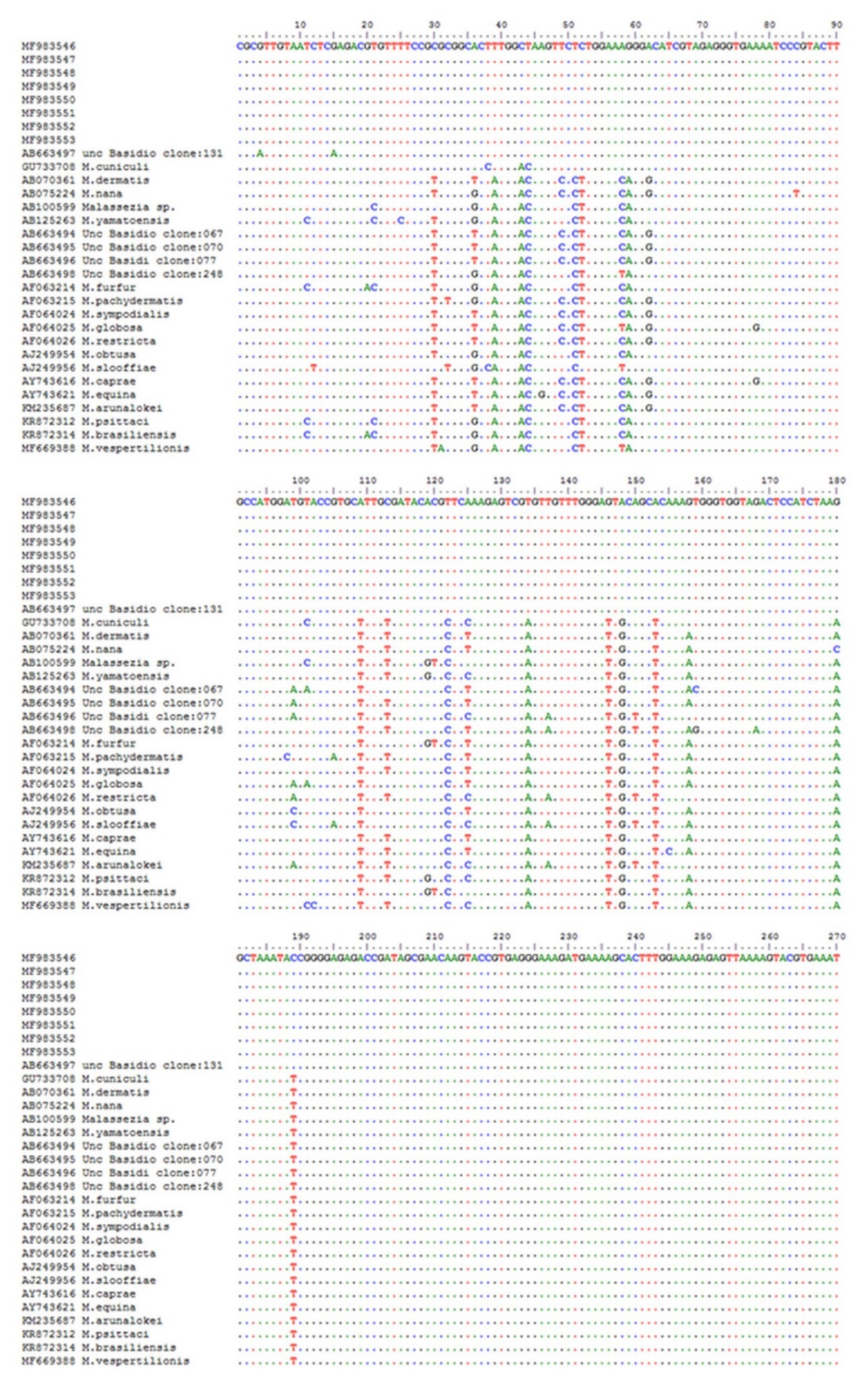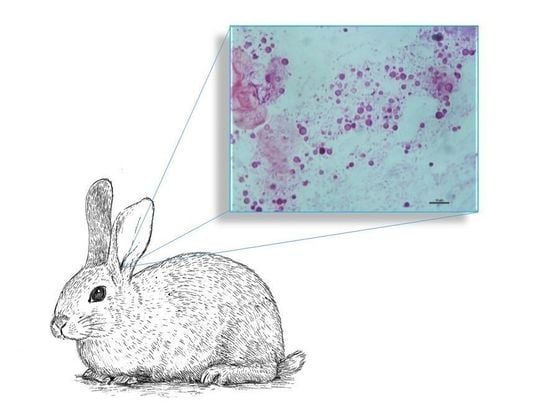Survey on the Presence of Malassezia spp. in Healthy Rabbit Ear Canals
Abstract
1. Introduction
2. Materials and Methods
3. Results
4. Discussion
Author Contributions
Funding
Acknowledgments
Conflicts of Interest
References
- Wang, Q.-M.; Theelen, B.; Groenewald, M.; Bai, F.-Y.; Boekhout, T. Moniliellomycetes and Malasseziomycetes, two new classes in Ustilaginomycotina. Persoonia-Mol. Phylogeny Evol. Fungi 2014, 33, 41–47. [Google Scholar] [CrossRef] [PubMed]
- Dufait, R. Presence of Malassezia pachydermatis (syn. Pityrosporum canis) on the hairs and feathers of domestic animals. Bulletin De La Société Française De Mycologie Médicale 1985, 14, 19–22. (in French). [Google Scholar]
- Guillot, J.; Chermette, R.; Guého, E. Prevalence of the genus Malassezia in mammals. J. Mycol. Med. 1994, 4, 72–79. [Google Scholar]
- Quevedo, M.U.; Lescano, J.G.; Fernández, V.A. Malassezia spp. Associated Dermatitis jn a Pet Rabbit (Oryctolagus Cuniculus). Revista De Investigaciones Veterinarias Del Perú (RIVEP) 2013, 24, 565–570. (in Spanish). [Google Scholar]
- Radi, Z. Outbreak of sarcoptic mange and malasseziasis in rabbits (Oryctolagus cuniculus). Comp. Med. 2004, 54, 434–437. [Google Scholar]
- Cabañes, F.J.; Vega, S.; Castellá, G. Malassezia cuniculisp. nov., a novel yeast species isolated from rabbit skin. Med. Mycol. 2011, 49, 40–48. [Google Scholar] [CrossRef]
- Quinton, J.F.; Francois, M.; Laprais, A.; Prelaud, P. Cytology of the external auditory meatus in healthy domestic pet rabbit (Oryctolagus cuniculus). Revue. Med. Vet. 2014, 165, 263–266. [Google Scholar]
- Galuppi, R.; Bonoli, C.; Guardini, G.; Ostanello, F.; Tampieri, M.P. Variability of Malassezia pachydermatis: An Italian experience and brief review of literature. Med Mycol. Mikol. 2010, 17, 87–96. [Google Scholar]
- Hall, T. Bioedit: A user-friendly biological sequence alignment editor and analysis program for Windows 95/98/NT. In Nucleic Acids Symposium Series; Information Retrieval Limited: London, UK, 1999; pp. 95–98. [Google Scholar]
- Zhang, E.; Tanaka, T.; Tsuboi, R.; Makimura, K.; Nishikawa, A.; Sugita, T. Characterization of Malassezia microbiota in the human external auditory canal and on the sole of the foot. Microbiol. Immunol. 2012, 56, 238–244. [Google Scholar] [CrossRef]
- Cabañes, F.J.; Puig, L.; Bragulat, M.R.; Castellá, G.; Coutinho, S.D.A. New lipid-dependent Malassezia species from parrots. Revista Iberoamericana de Micología 2016, 33, 92–99. [Google Scholar] [CrossRef]
- Honnavar, P.; Prasad, G.S.; Ghosh, A.; Dogra, S.; Handa, S.; Rudramurthy, S.M. Malassezia arunalokei sp. nov., a Novel Yeast Species Isolated from Seborrheic Dermatitis Patients and Healthy Individuals from India. J. Clin. Microbiol. 2016, 54, 1826–1834. [Google Scholar] [CrossRef] [PubMed]
- Lorch, J.M.; Palmer, J.M.; Vanderwolf, K.; Schmidt, K.; Verant, M.; Weller, T.; Blehert, D. Malassezia vespertilionis sp. nov.: A new cold-tolerant species of yeast isolated from bats. Persoonia-Mol. Phylogeny Evol. Fungi 2018, 41, 56–70. [Google Scholar] [CrossRef] [PubMed]
- White, S.D.; Bourdeau, P.J.; Meredith, A.L. Dermatologic problems of rabbits. Semin. Avian Exot. Pet Med. 2002, 11, 141–150. [Google Scholar] [CrossRef]
- Snook, T.S.; White, S.D.; Hawkins, M.G.; Tell, L.A.; Wilson, L.S.; Outerbridge, C.A.; Ihrke, P.J. Skin diseases in pet rabbits: A retrospective study of 334 cases seen at the University of California at Davis, USA (1984-2004). Vet.-Dermatol. 2013, 24, 613–617, e148. [Google Scholar] [CrossRef] [PubMed]
- Velegraki, A.; Cafarchia, C.; Gaitanis, G.; Iatta, R.; Boekhout, T. Malassezia Infections in Humans and Animals: Pathophysiology, Detection, and Treatment. PLOS Pathog. 2015, 11, e1004523. [Google Scholar] [CrossRef]
- Bond, R.; Anthony, R.M. Characterization of markedly lipid-dependentMalassezia pachydermatisisolates from healthy dogs. J. Appl. Bacteriol. 1995, 78, 537–542. [Google Scholar] [CrossRef]
- Aizawa, T.; Kano, R.; Nakamura, Y.; Watanabe, S.; Hasegawa, A. The genetic diversity of clinical isolates of Malassezia pachydermatis from dogs and cats. Med. Mycol. 2001, 39, 329–334. [Google Scholar] [CrossRef]
- Cafarchia, C.; Gasser, R.B.; Latrofa, M.S.; Parisi, A.; Campbell, B.E.; Otranto, D. Genetic variants of Malassezia pachydermatis from canine skin: Body distribution and phospholipase activity. FEMS Yeast Res. 2008, 8, 451–459. [Google Scholar] [CrossRef][Green Version]
- Galuppi, R.; Tampieri, M.P. Epidemiology and variability of Malassezia spp. Parassitologia 2008, 50, 73–76. [Google Scholar]
- Cabañes, F.J. Malassezia Yeasts: How Many Species Infect Humans and Animals? PLOS Pathog. 2014, 10, e1003892. [Google Scholar] [CrossRef]
- Kaga, M.; Sugita, T.; Nishikawa, A.; Wada, Y.; Hiruma, M.; Ikeda, S. Molecular analysis of the cutaneous Malassezia microbiota from the skin of patients with atopic dermatitis of different severities. Mycoses 2009, 54, e24–e28. [Google Scholar] [CrossRef] [PubMed]
- Soares, R.C.; Zani, M.B.; Arruda, A.C.B.B.; De Arruda, L.H.F.; Paulino, L.C. Malassezia Intra-Specific Diversity and Potentially New Species in the Skin Microbiota from Brazilian Healthy Subjects and Seborrheic Dermatitis Patients. PLoS ONE 2015, 10, e0117921. [Google Scholar] [CrossRef] [PubMed]
- Jung, W.H.; Croll, D.; Cho, J.H.; Kim, Y.R.; Lee, Y.W. Analysis of the nasal vestibule mycobiome in patients with allergic rhinitis. Mycoses 2015, 58, 167–172. [Google Scholar] [CrossRef]
- Puig, L.; Castellá, G.; Cabañes, F.J. Quantification of Malassezia pachydermatis by real-time PCR in swabs from the external ear canal of dogs. J. Vet.-Diagn. Investig. 2019, 31, 440–447. [Google Scholar] [CrossRef]
- Fell, J.W.T.; Boekhout, A.; Fonseca, G.; Scorzetti, G.; Statzell-Tallman, A. Biodiversity and systematics of basidiomycetous yeasts as determined by large-subunit rDNA D1/D2 domain sequence analysis. Int. J. Syst. Evol. Microbiol. 2000, 50, 1351–1371. [Google Scholar] [CrossRef] [PubMed]



| Component | LNA | Medium A | Medium B | Medium C | Medium D | Medium E | Medium F | Medium G | Medium H | Medium I |
|---|---|---|---|---|---|---|---|---|---|---|
| Peptone1 | 10 g | 10 g | 6 g | 10 | 10 g | 10 g | 10 g | 10 g | 10 g | 10 g |
| Glucose2 | 5 g | 5 g | 5 g | 5 g | 5 g | 5 g | 5 g | 5 g | 5 g | 5 g |
| Yeast extract1 | 0.1 g | 0.1 g | 0.5 g | 0.1 | 0.1 | 0.1 g | 0.1 g | 0.1 g | 0.1 g | 0.1 g |
| Bile bovine2 | 4 g | 4 g | 4 g | 4 g | 4 g | 20 g | 4 g | 4 g | 4 g | 20 g |
| Glycerol2 | 1 mL | - | 1 mL | 1 mL | 1 mL | 1 mL | 1 mL | 1 mL | 1 mL | 1 mL |
| Glycerol monostearate3 | 0.5 g | 0,5 g | 0.5g | 0.5 | 0.5 g | 0.5 g | 0.5 g | 0.5 g | 0.5 g | 0.5 g |
| Tween 602 | 0.5 mL | 0.5 mL | 0.5 mL | 0.5 | 0.5 mL | 0.5 | - | - | - | - |
| Tween 402 | - | 0.5 mL | - | 0.5 | 0.5 mL | - | - | - | - | - |
| Tween 802 | - | - | - | - | - | - | - | 0.5 mL | - | - |
| Tween 202 | - | - | - | - | - | - | - | - | 0.5 mL | - |
| Cholesterol2 | - | - | - | 10 mg | - | - | - | - | - | - |
| Boiling extract of ear rabbit6 | - | - | - | - | 10 mL | - | - | - | - | - |
| Oleic acid2 | - | - | - | - | - | - | 0.5 mL | - | - | - |
| Olive oil4 | - | - | - | - | - | - | - | - | - | 10 mL |
| Malt extract1 | - | - | 3 g | - | - | - | - | - | - | - |
| Whole-fat cows milk5 | 10 mL | 10 mL | 10 mL | 10 mL | 10 mL | 10 mL | 10 mL | 10 mL | 10 mL | 10 mL |
| Agar1 | 12 g | 12 g | 12g | 12 g | 12 g | 12 g | 12 g | 12 g | 12 g | 12 g |
| Housing Methods | Breeding | |||||
|---|---|---|---|---|---|---|
| Home (%) | Cage (%) | Rural (%) | Meat (%) | Companion (%) | ||
| Sex* | Males | 43 (50) | 34 (49.3) | 6 (46.1) | 32 (45.7) | 51 (52) |
| Females | 43 (50) | 35 (50.7) | 7 (53.9) | 38 (54.3) | 47 (48) | |
| Age | ≤ 3months | 20 (23.3) | 41 (59.4) | 11 (84.6) | 52 (74.3) | 20 (20.4) |
| > 3 months | 66 (76.7) | 28 (40.6) | 2 (15.4) | 18 (25.7) | 78 (79.6) | |
| Feeding | Mixeda | 86 (100) | 32 (46.4) | 13 (100) | 33 (47.1) | 98 (100) |
| Pellet | 0 | 37 (53.6) | 0 | 37 (52.9) | 0 | |
| Total | 86 | 69 | 13 | 70 | 98 | |
| Predictors | Categories | Percentages (%) | χ2 coeff. | P-Value |
|---|---|---|---|---|
| Production systems | Meat | 72.9 | 10.41 | 0.001 |
| Companion | 48 | |||
| Sex | Female | 67.1 | 5.39 | 0.02 |
| Male | 49.4 | |||
| Age | ≤3 months | 68.1 | 4.9 | 0.027 |
| >3 months | 51 | |||
| Housing methods | Home | 54.6 | 6.747 | 0.034 |
| Cage | 56.5 | |||
| Rural | 92.3 | |||
| Feeding | Pellet | 83.8 | 12.65 | <0.001 |
| Mixed | 51.1 |
© 2020 by the authors. Licensee MDPI, Basel, Switzerland. This article is an open access article distributed under the terms and conditions of the Creative Commons Attribution (CC BY) license (http://creativecommons.org/licenses/by/4.0/).
Share and Cite
Galuppi, R.; Morandi, B.; Agostini, S.; Dalla Torre, S.; Caffara, M. Survey on the Presence of Malassezia spp. in Healthy Rabbit Ear Canals. Pathogens 2020, 9, 696. https://doi.org/10.3390/pathogens9090696
Galuppi R, Morandi B, Agostini S, Dalla Torre S, Caffara M. Survey on the Presence of Malassezia spp. in Healthy Rabbit Ear Canals. Pathogens. 2020; 9(9):696. https://doi.org/10.3390/pathogens9090696
Chicago/Turabian StyleGaluppi, Roberta, Benedetto Morandi, Silvia Agostini, Sara Dalla Torre, and Monica Caffara. 2020. "Survey on the Presence of Malassezia spp. in Healthy Rabbit Ear Canals" Pathogens 9, no. 9: 696. https://doi.org/10.3390/pathogens9090696
APA StyleGaluppi, R., Morandi, B., Agostini, S., Dalla Torre, S., & Caffara, M. (2020). Survey on the Presence of Malassezia spp. in Healthy Rabbit Ear Canals. Pathogens, 9(9), 696. https://doi.org/10.3390/pathogens9090696






